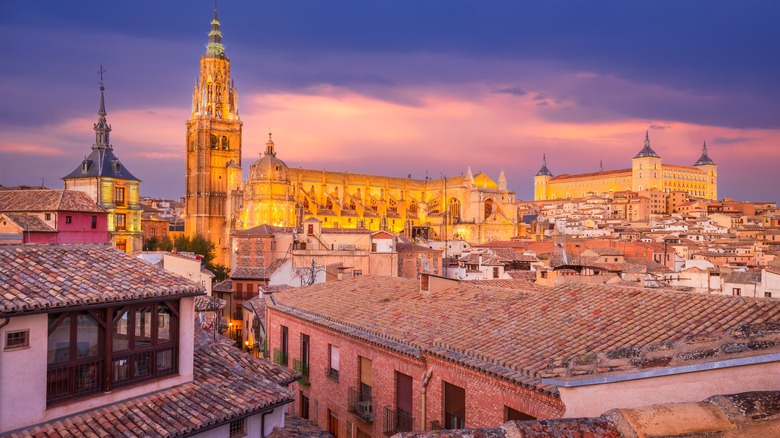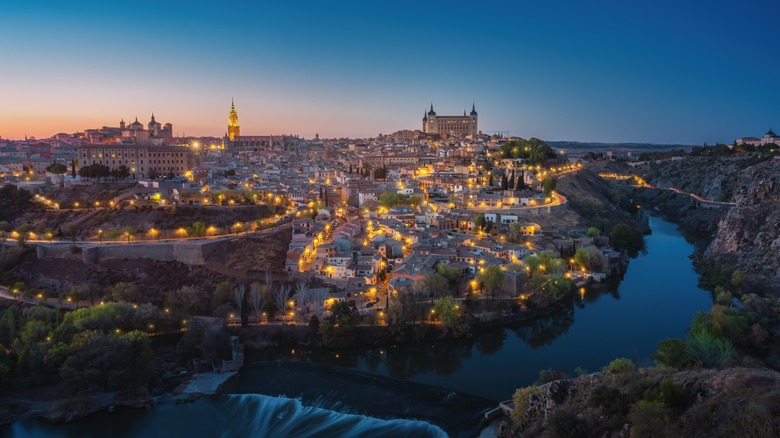Why Rick Steves Thinks Visiting Toledo, Spain At Night Is Much More Enjoyable
Ah, Toledo, Spain — an ancient medieval city steeped in beauty and history. Perched atop a hill surrounded by the Tagus River, this formal capital of Spain is one of the country's most visually striking and historically layered cities. Often referred to as the "City of Three Cultures" due to the coexistence of the Christian, Muslim, and Jewish communities during the Middle Ages, Toledo is a living, breathing museum — a labyrinth of narrow alleys, fortress walls, and centuries-old buildings. It also happens to be one of the most popular day trips from Madrid, about an hour's distance away.
With such popularity, unfortunately, comes crowds, and no man has a greater detest for overcrowded tourist destinations (but still secretly loves them) than travel aficionado Rick Steves. But not to fear, avid travelers, because Steves comes bearing tips and tricks for best practices regarding avoiding them. Ok, so maybe it's just one tip, but it's a good one!
The key, he says in his piece "Europe's Best-Preserved Towns," to experiencing Toledo in its prime, is to "miss the bus and spend the night!". When the last tour buses leave, the souvenir shops close, and the midday heat begins to subside, this is when Toledo undergoes a quiet transformation. As Steves says, "After dark, Toledo is much more medieval — almost haunted in some corners." The cathedral bells echo through empty stone alleyways, and the glow from the lamplights casts soft shadows against ancient walls. In the stillness of the evening, the monuments remain the same, but the experience of walking among them becomes more tangible, and you begin to feel history coming to life.
The medieval magic of Toledo
There's no denying that Toledo is impressive by day — why else would it be such a popular day trip? Visitors come from Madrid to tour its gorgeous cathedral (one of Spain's stunning Gothic masterpieces), the magnificent Alcázar, the beautiful Synagogue of Santa María la Blanca, and the El Greco Museum, showcasing the work of the city's famously adopted artist. Add in blacksmith shops, marizpan stalls, and panoramic views, and it's easy to see why it's such a hit with tourists.
As Steves and many seasoned travelers will tell you, however, the real Toledo starts to show its "medieval magic" when the crowds disperse. With fewer visitors, the city becomes calm, walkable, and intimate. You no longer need to dodge selfie sticks or navigate long lines. Instead, you can walk peacefully around a quiet plaza, listen to the cathedral bells toll, and enjoy the stillness. The lighting at night also plays a large role in Toledo's beauty. Aside from lamplight casting shadows on the many pieces of medieval architecture, the views at sunset from either the Paseo de Recaredo or the Puente de San Martin of the city walls and the river below are stunning.
If you're driving or don't mind a walk or short taxi ride, go to the Mirador del Valle, across the river. This viewpoint offers one of the most famous panoramic views of the city, and it's especially stunning at night when the skyline is lit and reflected in the river. It's the quintessential Toledo postcard view, minus the crowds.
What to do at night in Toledo
While the cathedral may be closed in the evening, the surrounding plaza is often quiet and peaceful. The Gothic facade is lit dramatically, and it's easy to imagine what it may have looked like during medieval times. It's a great place to pause and take in the architectural beauty without distractions. You can also join a night walking tour. While some companies focus on telling tales of ghosts and legends in the dark alleyways, others tell tales of Toledo's deep history. These tours often wind through lesser-known corners of the city, telling stories that bring shadows to life. And, unlike daytime tours, these groups are often smaller and more intimate.
While here in the evening, why not enjoy a scenic dinner? At night, visitors will find smaller bars and restaurants that aren't pushing their tourist trap menus out. This is the best time to sit with a glass of Spanish wine, and as Steves recommends, "end your day with a feast of roast suckling pig somewhere in the dark tangle of nighttime Toledo." If you're planning on missing the bus or train back, you'll need a place to sleep (unless you decide to join the Spanish tradition of partying until the early morning hours).
Spending the night allows you to enjoy the best of both worlds — seeing the major sites during the early or later parts of the day, and avoiding the midday surge. Many hotels are located in restored historic buildings, offering an atmosphere to match the stunning surroundings. Steves suggests that "while Toledo's Parador Nacional Conde de Orgaz is one of Spain's most famous luxury hotels, I'd enjoy its grand city view over coffee without suffering through its stuffy management and clientele overnight. Instead, sleep in a 17th-century cardinal's palace built right into the old town wall, the Hacienda del Cardenal."


